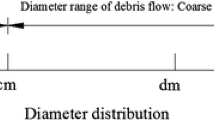Abstract
Measuring the internal velocity of debris flows is very important for debris flow dynamics research and designing debris flow control works. However, there is no appropriate method for measuring the internal velocity because of the destructive power of debris flow process. In this paper, we address this problem by using the relationship between velocity and kinetic pressure, as described by surface velocity and surface kinetic pressure data. Kinetic pressure is the difference of impact pressure and static pressure. The former is detected by force sensors installed in the flow direction at the sampling section. Observations show that static pressure can be computed using the formula for static water pressure by simply substituting water density for debris flow density. We describe the relationship between surface velocity and surface kinetic pressure using data from seven laboratory flume experiments. It is consistent with the relationship for single phase flow, which is the measurement principle of the Pitot tube.
Similar content being viewed by others
References
Arattano M, Deganutti AM, Marchi L (1997) Debris flow monitoring activities in an instrumented watershed on the Italian Alps. In: Chen, C.L. (ed.), Proceedings of 1st International Conference on Debris-flow Hazards Mitigation: Mechanics, Prediction and Assessment. New York: ASCE, pp 506–515.
Arattano M, Grattoni P (2000) Using a fixed video camera to measure debris-flow surface velocity. In: Wieczorek GF, Naeser ND (eds.), Debris-flow Hazards Mitigation: Mechanics, Prediction and Assessment. Proceedings of the second international conference. Rotterdam: AA Balkema, pp 273–281.
Arattano M, Marchi L (2005) Measurements of debris flow velocity through cross-correlation of instrumentation data. Natural Hazards and Earth System Sciences, 5(1): 137–142.
Berti M, Genevois R, LaHusen R, et al (2000) Debris flow monitoring in the Acquabona Watershed on the Dolomites (Italian Alps). Physics and Chemistry of the Earth (B) 25(9): 707–715.
Boyarskiy IY, Vlasov AY, Kolyada MS (1970) An instrument for measuring surface velocity of water-and-Rubble flows. Vestnik Moskovskogo Universiteta, Seriya Geografiya (3): 82–87. (in Russian).
Fleishman SM (1986) Debris Flow. Translated by Yao D, Beijing: Science Press. p 290. (In Chinese)
Gagoshidze MS (1970) Debris flows: phenomena and mitigation. Tbilisi: Sabchota Sakartvelo, pp 385 (In Russian).
Hanisch J, Ergenzinger P, Bonte M (2003) Dumpling — an “intelligent” boulder for studying internal process of debris flows. In: Rickenmann D, Chen CL (eds.), Debris-flow Hazards Mitigation: Mechanics, Prediction, and Assessment. Proceedings of the Third International Conference. Rotterdam: Millpress, pp 843–849.
Inaba H, Uddin MS, Itakura Y, et al. (1997) Surface velocity vector field measurement of debris flow based on spatio temporal derivative space method. In: Chen, C.L. (ed.), Proceedings of 1st International Conference on Debris-flow Hazards Mitigation: Mechanics, Prediction and Assessment. New York: ASCE, pp 757–766.
Inaba H, Itakura Y, Kasahara M (2000) Surface velocity computation of debris flows by vector field measurements. Physics and Chemistry of the Earth (B), 25(9): 741–744.
Itakura Y, Ogawa K, Suwa H, et al. (1985) Trends and fluctuation of the surface-velocity of debris flow measured by a non-contact speed sensor with a spatial filter. In: Harada, M. (ed.), Fluid control and measurement. Tokyo: Pergamon Press, pp 781–786.
Itakura Y, Koga Y, Takahama J, et al. (1997) Acoustic detection sensor for debris flow. In: Chen, C.L. (ed.), Proceedings of 1st International Conference on Debris-flow Hazards Mitigation: Mechanics, Prediction and Assessment. New York: ASCE, pp 747–756.
Itakura Y, Kitajima T, Endo K, et al. (2000) A new double dualaxes accelerometer debris-flow detection system. In: Wieczorek GF, Naeser ND (eds.), Debris-flow Hazards Mitigation: Mechanics, Prediction and Assessment. Proceedings of the Second International conference. Rotterdam: AA Balkema, pp 273–281.
Kang Z, Hu P (1990) Measurements for Kinematic Parameters of debris flows in Jiangjia Gully. In: Wu J, Kang Z, Tian L, et al. (eds.) Observation researches on debris flows in Jiangjia Gully, Yunnan. Beijing: Science Press, pp 99–140. (In Chinese)
Kherhkeulidze GI (1984) Debris flow pressure and methods of its determination. In: Trudy ZakNIGMI (Proceedings of Trans-Caucasian Regional Scientific Research Institute of Hydrometeorology). Moscow: Gidrometeoizdat, 83(90):77–112. (In Russian).
Natishvili OG, Tevzadze VI, Iordanishvili ZS (1963) Determination of debris flow velocity in linear parts of the channel. In: Trudy GruzNIIGIM (Proceedings of Georgian Scientific Research Institute of Hydrotechnics and Melioration), Tbilisi, 22:243–248. (In Russian).
Pierson TC (1986) Flow behavior of channelized debris flows, Mount St. Helens, Washington. In: Abrahms AD (ed.), Hillslope Processes. Boston: Allen & Unwin, pp 269–296.
Stepanov BS (1982) Main characteristics of debris flows and debris-flow deposits. Methods of measurements. In: Trudy KazNIGMI (Proceedings of Kazakh Regional Scientific Research Institute of Hydrometeorology). Moscow: Gidrometeoizdat, 79:1–135. (In Russian).
Suwa H, Okunishi K, Sakai M (1993) Motion, debris size and scale of debris flows in a valley on Mount Yajkedake, Japan. In: Sediment Problems: Strategies for Monitoring, Prediction and Control, Proceedings of the Yokohama Symposium, July 1993. IAHS Publ, pp 239–248.
Uddin MS, Inaba H, Itakura Y, et al. (1998) Estimation of the surface velocity of debris flow with computer-based spatial filtering. Applied Optics, 37(26): 6234–6239.
Uddin MS, Inaba H, Itakura Y, et al. (1999) Adaptive computer-based spatial-filtering method for more accurate estimation of the surface velocity of debris flow. Applied Optics, 38(32): 6714–6721.
Uddin MS, Inaba H, Yoshida Y, et al. (2001) Large motion estimation by gradient technique — application to debris flow velocity field. Physics and Chemistry of the Earth (C), 26(9): 633–638.
Zhang S (1993) A comprehensive approach to the observation and prevention of debris flows in China. Natural Hazards, 7(1): 1–23.
Zhang S, Yuan J (1985) Impact force of debris flow and its detection. In: Memoirs of Lanzhou Institute of Glaciology and Cryopedology, Chinese Academy of Sciences. Beijing: Science Press, pp 269–274. (In Chinese)
Author information
Authors and Affiliations
Corresponding author
Rights and permissions
About this article
Cite this article
Yang, H., Wei, F., Hu, K. et al. Measuring the internal velocity of debris flows using impact pressure detecting in the flume experiment. J. Mt. Sci. 8, 109–116 (2011). https://doi.org/10.1007/s11629-011-2083-x
Received:
Accepted:
Published:
Issue Date:
DOI: https://doi.org/10.1007/s11629-011-2083-x



